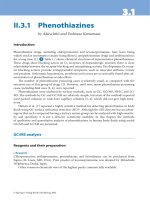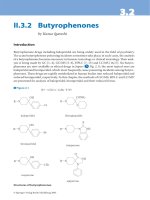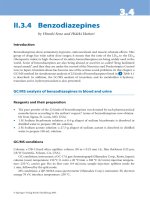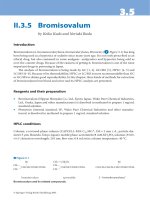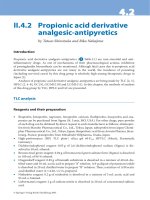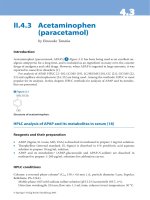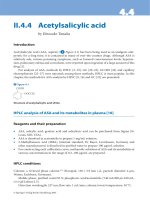Tài liệu Drugs and Poisons in Humans - A Handbook of Practical Analysis (Part 31) ppt
Bạn đang xem bản rút gọn của tài liệu. Xem và tải ngay bản đầy đủ của tài liệu tại đây (187.85 KB, 7 trang )
3.53.5
© Springer-Verlag Berlin Heidelberg 2005
II.3.5 Bromisovalum
by Keiko Kudo and Noriaki Ikeda
Introduction
Bromisovalum ( α-bromoisovalerylurea, bromovalerylurea, Brovarin)
(>
Figure 5.1) has long
been being used as a hypnotics or sedative since many years ago. It is not only prescribed as an
ethical drug, but also contained in some analgesic- antipyretics and hypnotics being sold as
over-the-counter drugs. Because of the easiness of getting it, bromisovalum is one of the most
important drugs in poisoning in Japan.
e analysis of bromisovalum is being made by GC [1, 2], GC/MS [3], HPLC [4, 5] and
LC/MS [6–8]. Because of its thermolability, HPLC or LC/MS is more recommendable than GC
or GC/MS to obtain good reproducibility. In this chapter, three kinds of methods for extraction
of bromisovalum from blood and urine and its HPLC analysis are presented.
Reagents and their preparation
• Bromisovalum (Nippon Shinyaku Co., Ltd., Kyoto, Japan, Wako Pure Chemical Industries,
Ltd., Osaka, Japan and other manufacturers) is dissolved in methanol to prepare 1 mg/mL
standard solution.
• Phenytoin (internal standard, IS
a
, Wako Pure Chemical Industries and other manufac-
turers) is dissolved in methanol to prepare 1 mg/mL standard solution.
HPLC conditions
Column: a reversed-phase column ( CAPCELL-PAK C
18
MG
b
, 250 × 3 mm i. d., particle dia-
meter 5 µm, Shiseido, Tokyo, Japan); mobile phase: acetonitrile/8 mM KH
2
PO
4
solution (35:65,
v/v)
c
; detection wavelength: 210 nm; ow rate: 0.8 mL/min; column temperature: 40 °C.
Bromisovalum and its related compounds.
⊡ Figure 5.1
294 Bromisovalum
Procedures
i. Extraction with an Extrelut column [9]
i. A 1-mL (or g) aliquot of a specimen (whole blood, serum or urine) is mixed with 5 µL
phenytoin solution (IS, 1 mg/mL) and 1 mL of 0.1 M hydrochloric acid solution
d
in a cen-
trifuge tube.
ii. e mixture is vortex-mixed for 10 s.
iii. It is centrifuged (4 °C, 2,500 rpm, 15 min) to obtain a supernatant fraction.
iv. A 2.5-g aliquot of Extrelut
e
(Merck, Darmstadt, Germany) is packed in a glass column
(about 15 cm × 15 mm i. d.).
v. e above supernatant fraction is poured into the column and le for 20 min.
vi. Bromisovalum and IS are eluted with 7 mL ethyl acetate; the eluate is evaporated to dryness
under a stream of nitrogen.
vii. e residue is dissolved in 100 µL of the mobile phase; a 10-µL aliquot of it is injected into
HPLC.
ii. Extraction with a Sep-Pak C
18
cartridge [1]
i. A 1-mL (or g) aliquot of a specimen is mixed with distilled water (9 mL for a whole blood
specimen; 4 mL for serum and urine specimens) and 5 µL phenytoin solution (IS, 1 mg/mL)
in a centrifuge tube.
ii. e mixture is vortex-mixed for 10 s.
iii. It is centrifuged (4 °C, 2,500 rpm, 15 min) to obtain a supernatant fraction.
iv. A Sep-Pak C
18
cartridge (Waters, Milford, MA, USA) is activated by passing 5 mL of di-
chloromethane/methanol (9:1), 5 mL acetonitrile and 10 mL distilled water.
v. e above supernatant fraction is poured into the Sep-Pak cartridge, washed with 10 mL
distilled water and eluted with 3 mL of dichloromethane/methanol (9:1).
vi. A er removal of a small amount of the upper layer (aqueous phase) of eluate with a Pasteur
pipette, the organic eluate is evaporated to dryness under a stream of nitrogen.
vii. e residue is dissolved in 100 µL of the mobile phase, and a 10-µL aliquot is injected into
HPLC.
iii. Liquid-liquid extraction [5]
i. A 1-mL (or g) aliquot of a specimen (whole blood, serum or urine) is mixed with 5 µL of
phenytoin solution (IS, 1 mg/mL) and 1 mL of 0.1 M hydrochloric acid solution in a cen-
trifuge tube.
ii. A 3-mL volume of tert-butyl methyl ether
f
(Tokyo Kasei Kogyo Co., Ltd., Tokyo, Japan and
other manufacturers) is added to the above mixture and vortex-mixed for 2 min.
iii. It is centrifuged (4 °C, 2,500 rpm, 15 min).
iv. e organic phase is transferred to a glass vial, and evaporated to dryness under a stream
of nitrogen.
v. e residue is dissolved in 100 µL of the mobile phase, and a 10-µL aliquot is injected into
HPLC.
295
Assessment and some comments on the methods
> Figure 5.2 shows HPLC chromatograms for whole blood specimens, which had been
extracted with an Extrelut column. e peaks of bromisovalum and IS appeared at 3.77 and
6.22 min, respectively, without any interfering peak. e calibration curve showed excellent
linearity in the range of 0.1–10 µg/mL; recovery rates were 60–80 %. When ethenzamide is
used as IS, it appears before bromisovalum; when 2-bromohexanoylurea is used as IS, it ap-
pears a er phenytoin. By extraction with Extrelut or Sep-Pak C
18
, there is occasionally a case
in which bromisovalum is not separated from other basic drugs, when they are ingested simul-
taneously. By the liquid-liquid extraction, the basic drugs can be removed e ciently; but col-
oration of the organic phase takes place to some extent, when whole blood is analyzed.
> Figure 5.3 shows an HPLC chromatogram of the extract of rat plasma obtained 2 h a er
intraperitoneal administration of bromisovalum (30 mg/kg) [5]. Because of the di erent HPLC
conditions, the retention times were somewhat di erent; but a de-bromo-metabolite ( 3-methyl
butyrylurea) appeared before ethenzamide.
As over-the-counter drugs containing bromisovalum, Rislon (100 mg bromisovalum per
tablet, Sato Pharmaceutical, Tokyo, Japan) and Wutt (83 mg bromisovalum, 50 mg apronalide
and 8.3 mg diphenhydramine hydrochloride per tablet, Itami Pharmaceutical, Shiga, Japan)
can be mentioned. Apronalide (
> Figure 5.1) contained in Wutt appears at 5.07 min under
the present HPLC conditions and thus can be an indicator of ingestion of Wutt.
In some analgesic-antipyretics, bromisovalum is also contained together with acetamino-
phen and ethenzamide. erefore, when bromisovalum is detected, various possibilities of
concomitant ingestion of other drugs should be taken into consideration.
HPLC chromatograms for blood extracts in the presence and absence of bromisovalum and IS.
The concentration of bromisovalum spiked into whole blood was 5 µg/mL.
⊡ Figure 5.2
Bromisovalum
296 Bromisovalum
Toxic and fatal concentrations
Fatal blood bromisovalum concentrations in poisoning with bromisovalum only were reported
to be 44.0–93.8 µg/mL by Hishida [10], 67–134 µg/mL by Maguchi [11] and 114 µg/mL by
Kojima et al. [12]. In the fatal cases of multiple drug ingestion, blood bromisovalum concentra-
tions were reported to be 37 µg/mL by Terada et al. [13], 23.6 µg/mL by Matsubara et al. [14],
and 31.5 and 40.8 µg/mL by Yashiki et al. [15].
Poisoning cases
Many cases of poisoning by bromisovalum were reported. In this section, representative clinical
and medicolegal cases are presented.
a) Cases in clinical toxicology [16]
Case 1: a 26-year-old male ingested more than 3 g bromisovalum and his consciousness level
was 300 (Japan Coma Scale) on arrival at a hospital. His clinical blood tests were: the maxi-
HPLC chromatogram for the extract of rat serum obtained 2 h after intraperitonal injection of
bromisovalum (30 mg/kg). HPLC conditions; column: Symmetry Shield RP
18
, 15 cm × 4.6 mm i. d.,
particle diameter 3.5 µm, Waters; mobile phase: acetonitrile/8 mM KH
2
PO
4
solution (35:65, v/v);
detection wavelength: 210 nm; flow rate: 0.4 mL/min.
⊡ Figure 5.3
297
mum blood bromisovalum concentration, 235 µg/mL; bromide (Br) 1.4 mE/L (on day 2 of
admission) and chloride (Cl), 151 mEq/L
g
. e half-life of bromisovalum was 12.6 h; that of
bromide 92.7 h. e consciousness levels were in good parallel with blood concentrations of
bromisovalum.
Case 2: a 29-year-old female ingested 20.4 g of bromisovalum. e maximum blood
bromisovalum concentration was 117.3 µg/mL on arrival at a hospital; the concentration of
chloride was 119 mEq/L. Her consciousness levels were improved according to the decrease in
the bromisovalum levels. e chloride levels did not correlate with the consciousness levels.
Case 3: a 57-year-old female fell into cardiopulmonary arrest due to asphyxia, but was re-
suscitated by a rescue squad, and brought to a hospital. A 0.4-g aliquot of bromisovalum had
been prescribed for her to sleep. Her blood bromisovalum concentration was 10.1 µg/mL on
her arrival to the hospital; chloride concentration 177 mEq/L. Bromide concentrations de-
creased with a half-life of 58.3 h.
b) Medicolegal cases
Case 1 [12]: a 43-year-old housewife was missing. A er 4 days, she was found dead in a shed
located in a rice eld. Her autopsy ndings were: height, 151 cm; weight, 49 kg; mild subcuta-
neous hemorrhages observable in the chest, abdomen and extremities; and lung edema (le
lung 460 g, right lung 440 g). Except these ndings, neither severe injuries nor diseases were
found. e stomach contents consisted of 14 g of white clayey substance and about 350 mL of
aqueous solution. About 350 mL urine was present in her urinary bladder.
Analytical results: 3 g of bromisovalum was detected from the above white clayey sub-
stance; about 1 g of the same drug detected from the aqueous solution. Bromisovalum concen-
trations were 114, 140, 123 and 55 µg/mL or g in blood, the brain, liver and urine, respectively.
It was diagnosed that the cause of her death was bromisovalum poisoning.
Case 2 [17]: human skeletal remains were discovered in a bush located in a suburban area
of a big city. Next to the remains, three empty bottles, to which labels describing 100 tablets
of bromisovalum had been attached, ve unopened bottles containing the same tablets and a
1.5-L volume plastic bottle containing about a half volume of water were found. By dental nd-
ings, the remains were found to be a 46-year-old male who had been missing for 7 months.
Using the femoral bone marrow, the analysis of bromisovalum was conducted by GC/MS and
LC/MS. e drug was identi ed by the methods; its concentrations measured by LC/MS were
93.8 and 26.0 µg/g in the right and le femoral bones, respectively.
Notes
a) As an IS, ethenzamide can be used. For LC/MS analysis of bromisovalum, 2-bromohexano-
ylurea, showing very similar physicochemical properties, is most suitable as IS [7, 18, 19].
is compound can be easily synthesized with 2-bromohexanoyl bromide and urea: 5 g of
2-bromohexanoyl bromide (Aldrich, Milwaukee, WI, USA) and an equimolar amount of
urea are placed in a 100 mL volume eggplant-shaped glass ask and warmed in a water bath
to form a so clay. A er warm distilled water is added to the clay, solid sodium bicarbonate
is gradually added to the mixture until the solution becomes alkaline with warming; this
Bromisovalum
